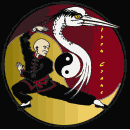|
 The White Lotus Sword System is an entire
martial art incorporated within Gun Fu. To think
of it exclusively as a sword system would be
misleading. Included within the course of study is
short stick (generally 12” long, made of hardwood”),
middle stick (We prefer 28”, and try to be consistent
with standards set by practitioners of Arnis.), jo (4
foot long “short staff”), and ultimately the sword. The White Lotus Sword System is an entire
martial art incorporated within Gun Fu. To think
of it exclusively as a sword system would be
misleading. Included within the course of study is
short stick (generally 12” long, made of hardwood”),
middle stick (We prefer 28”, and try to be consistent
with standards set by practitioners of Arnis.), jo (4
foot long “short staff”), and ultimately the sword.
Students
“elect” to pursue this as an individual pursuit at an
advanced level, and if they satisfy the criteria for
performance, knowledge, and maturity, they are given the
opportunity to test for Black Sash. Since most
students who learn the sword are already Black Belts,
there are no colored belts. You are simply a
student, a Black Sash teacher, or a Master.
Sword
arts reflect the many cultures of their respective
origins. They range from the speed, grace and
lightning precision of the foil, to the integrity,
penetration, and spirituality of the Japanese
sword. Of course every culture has its heroes with
the bladed weapons, and its own spin on what constitutes
the ideal fighting design.
Our
system has its roots in Northern China, and bears the
unmistakable stamps of Korean traditional arts, and Hap
Ki Do. The original forms came to the continental
United States with Dr. James Tille, who learned them
from Master Lee while studying Kuk Sool Won Hap Ki Do in
Korea. It was Dr. Tille who named the system
“White Lotus” and we honor his contribution to heritage
by keeping the name he chose. These were passed on
to myself and to others, and over the years, additional
moves and concepts were incorporated into the body of
knowledge bringing it to its present level. I have
personally seen what resembled sections of these forms
in Ai Ki Do, and in Tai Chi Dao (Chinese Sword Art), but
have come to no conclusion regarding commonality of
origin.
The
swords used in our system are light, quick and
sharp. If you tried a “Samurai” Sword, then a
White Lotus Sword, you would immediately feel the
lightness of the White Lotus Sword, sensing the balance
in your hand, and its willingness to move at your
command. Most who practice the system end up
getting someone to custom design a sword for them.
In my case, Master Roy Kauffroath has always seen to it
that I and my students have the finest weapons for our
pursuit. That is...he makes them as gifts of
friendship.
Originally,
six forms were adopted. Of the six, one is a
reverse hand kata, and another is a two sword
kata. They are remarkable in their configuration
because (with the exception of the two sword form) each
connects perfectly with any other, in any order.
On learning these block elements, you can a perform a
multitude of different forms by simply improvising (the
total number is 120, in case you wondered). Or,
once started, a practitioner can continue with a “never
ending” form.
So you see, there is quite a bit to this study of
swords.
In
addition to the above, the White Lotus Sword System has
incorporated two forms based on combining elements of
the original six, identified as Singing dragon
and Full Circle. Testing for the
Black Sash would include those eight forms, along the
the confidence of being able to use the weapon in
combat, and to react against a sword wielding attacker
while empty handed. Finally, there are two very
advanced two person forms, Twin Musashi’s Short
Form, and Twin Musashi’s Long
Form. These forms are for the
most serious students. They are demanding both
mentally and physically, and are seldom mastered in less
than five years.
Among the clips included are the original “core” sword
system, (White Lotus #1-6), and also Singing
Dragon, Full Circle and
Twin Musashis . The form labled
White Lotus #10 is a new discovery for us.
|

